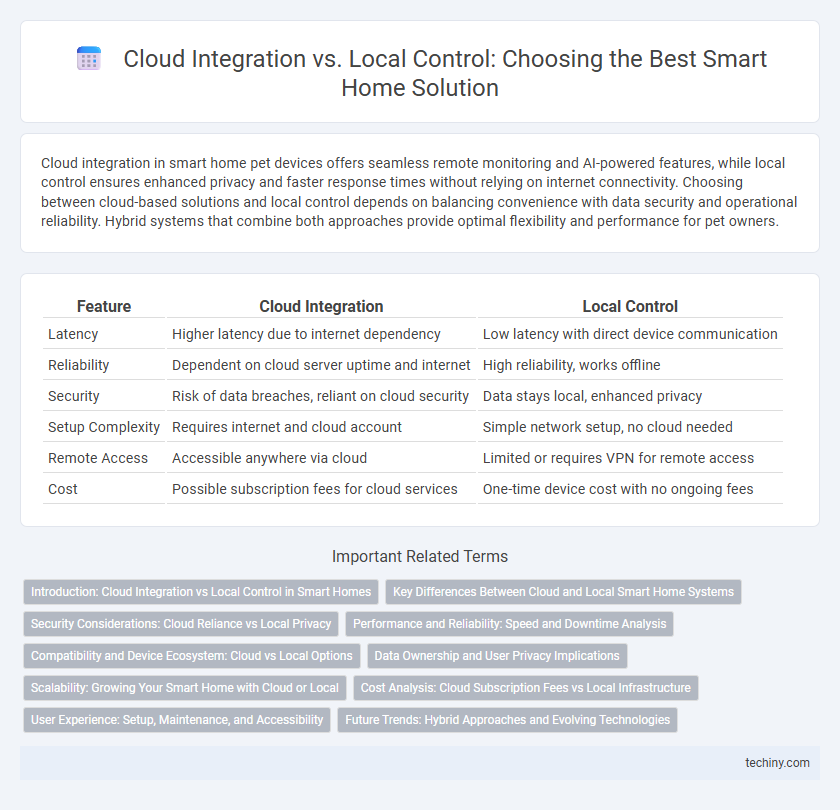Cloud integration in smart home pet devices offers seamless remote monitoring and AI-powered features, while local control ensures enhanced privacy and faster response times without relying on internet connectivity. Choosing between cloud-based solutions and local control depends on balancing convenience with data security and operational reliability. Hybrid systems that combine both approaches provide optimal flexibility and performance for pet owners.
Table of Comparison
| Feature | Cloud Integration | Local Control |
|---|---|---|
| Latency | Higher latency due to internet dependency | Low latency with direct device communication |
| Reliability | Dependent on cloud server uptime and internet | High reliability, works offline |
| Security | Risk of data breaches, reliant on cloud security | Data stays local, enhanced privacy |
| Setup Complexity | Requires internet and cloud account | Simple network setup, no cloud needed |
| Remote Access | Accessible anywhere via cloud | Limited or requires VPN for remote access |
| Cost | Possible subscription fees for cloud services | One-time device cost with no ongoing fees |
Introduction: Cloud Integration vs Local Control in Smart Homes
Cloud integration in smart homes enables remote access, automated updates, and seamless interoperability across devices by leveraging internet connectivity and centralized servers. Local control offers enhanced privacy, faster response times, and reliability by processing data on-site without dependence on external networks. Choosing between cloud integration and local control impacts security, latency, and overall smart home performance, making it essential to evaluate user needs and infrastructure capabilities.
Key Differences Between Cloud and Local Smart Home Systems
Cloud integration in smart home systems relies on remote servers to process data, offering scalability and seamless updates but depends heavily on internet connectivity. Local control systems operate independently within the home network, ensuring faster response times, enhanced privacy, and uninterrupted functionality during internet outages. Key differences include latency, data security, and reliance on external networks, influencing user trust and system reliability.
Security Considerations: Cloud Reliance vs Local Privacy
Cloud integration in smart homes offers seamless connectivity and remote access but raises significant security concerns due to data transmission and storage on external servers, increasing vulnerability to cyberattacks and unauthorized access. Local control systems enhance privacy by keeping data within the home network, minimizing exposure to external threats and reducing reliance on internet connectivity. Prioritizing local encryption and regular software updates is essential to maintain robust security in both cloud-based and local smart home configurations.
Performance and Reliability: Speed and Downtime Analysis
Local control in smart home systems offers faster response times and reduced latency by processing commands on-site, minimizing dependence on internet connectivity and cloud server availability. Cloud integration provides extensive data storage and remote access but may introduce delays due to network communication and potential outages. Evaluating downtime, local control ensures continuous operation during internet disruptions, enhancing reliability in performance-critical applications.
Compatibility and Device Ecosystem: Cloud vs Local Options
Cloud integration in smart homes offers extensive compatibility with a wide range of devices through centralized platforms like Amazon Alexa, Google Assistant, or Apple HomeKit, enabling seamless interaction across multiple brands and services. Local control systems operate independently of the internet, providing enhanced privacy and faster response times but often supporting a more limited device ecosystem confined to specific manufacturers or protocols such as Zigbee or Z-Wave. Choosing between cloud and local options depends on the desired balance between broad device compatibility and ecosystem interoperability versus autonomy and direct control within a smart home environment.
Data Ownership and User Privacy Implications
Cloud integration in smart homes enables remote access and enhanced functionality but raises concerns over data ownership as user information is stored on third-party servers, increasing vulnerability to breaches. Local control systems prioritize user privacy by keeping data within the home network, minimizing exposure to external threats and granting homeowners direct authority over their personal data. Choosing between cloud and local solutions impacts privacy policies and compliance requirements, making user awareness crucial for secure and responsible smart home management.
Scalability: Growing Your Smart Home with Cloud or Local
Cloud integration offers superior scalability for smart homes by enabling seamless addition of new devices and services through centralized management and remote access. Local control systems, while offering enhanced privacy and reduced latency, often face limitations in scaling due to hardware constraints and the complexity of managing multiple protocols. Choosing cloud-based platforms ensures easier expansion and integration with third-party services, supporting a growing and dynamic smart home ecosystem.
Cost Analysis: Cloud Subscription Fees vs Local Infrastructure
Cloud integration in smart homes often involves recurring subscription fees that can accumulate significantly over time, impacting overall cost efficiency. Local control systems require upfront investment in infrastructure such as hubs and servers but eliminate ongoing charges, offering long-term savings. Evaluating the cost-effectiveness depends on usage patterns, reliability needs, and scalability, with local control favoring cost-conscious users seeking autonomy from continuous fees.
User Experience: Setup, Maintenance, and Accessibility
Cloud integration in smart homes offers seamless remote access and effortless updates, enhancing user convenience and ensuring up-to-date features. Local control provides faster response times and greater privacy by processing data on-site, reducing dependence on internet connectivity. Balancing cloud benefits with local control can optimize setup simplicity, minimize maintenance issues, and improve accessibility across diverse user environments.
Future Trends: Hybrid Approaches and Evolving Technologies
Hybrid approaches in smart home systems combine cloud integration and local control to enhance security, reduce latency, and ensure seamless device operation during internet outages. Evolving technologies like edge computing and AI-driven automation enable more efficient data processing closer to the source, optimizing performance and user experience. Future trends indicate a shift towards adaptive architectures balancing cloud scalability with local autonomy to meet growing demands for privacy, speed, and reliability.
Cloud Integration vs Local Control Infographic

 techiny.com
techiny.com